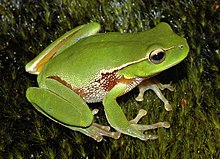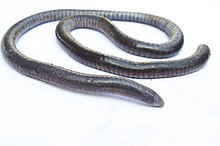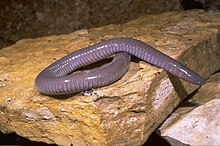Portal:Amphibians
The Amphibian Portal
The young generally undergo metamorphosis from larva with gills to an adult air-breathing form with lungs. Amphibians use their skin as a secondary respiratory surface and some small terrestrial salamanders and frogs lack lungs and rely entirely on their skin. They are superficially similar to reptiles like lizards, but unlike reptiles and other amniotes, require water bodies in which to breed. With their complex reproductive needs and permeable skins, amphibians are often ecological indicators; in recent decades there has been a dramatic decline in amphibian populations for many species around the globe.
The earliest amphibians
Selected frog article
List of selected frog articles
|
|---|
Selected salamander article
The Caudata are a group of amphibians containing the extant salamanders (the order Urodela) and all extinct species of amphibians more closely related to salamanders than to frogs. They are typically characterized by a superficially lizard-like appearance, with slender bodies, blunt snouts, short limbs projecting at right angles to the body, and the presence of a tail in both larvae and adults.
Disagreement exists between different authorities as to the definition of the terms "Caudata" and "Urodela". Some maintain that Urodela should be restricted to theList of selected salamander articles
|
|---|
|
Did you know? –

- ... that the Pyrenean brook salamandersometimes lives entirely underground in caves?
- ... that temnospondyl amphibians, was established as a cladein 2013?
- ... that the that was frequently eaten by the describers of the species?
- ... that the female tree frog Aplastodiscus leucopygius inspects the underground nesting chamber prepared by the male before accepting his advances?
- ... that the Italian pool frog (pictured) has been introduced into the United Kingdom?
Selected amphibian type
Modern caecilians are a
List of selected amphibian type articles
|
|---|
Selected images
-
Endemic to Spain, it mostly lives in open areas, pine groves and shrublands. It feeds mostly on insects and worms.Photograph: Brian GratwickeRabbs' fringe-limbed treefrog (Ecnomiohyla rabborum) is a large species of frog originally found in the forest canopies of central Panama. Only discovered in 2005, the species is thought to be extinct in the wild; only one specimen, a male at the Atlanta Botanical Garden, survives.Photograph: JJ HarrisonThe southern brown tree frog (Litoria ewingii) is a species of tree frog native to Australia found in a wide range of habitats. Reaching 45 millimetres (1.8 in), this species is generally brown, but green and green-striped morphs are also recorded.Photo: Benny TrappAn Italian tree frog (Hyla intermedia) with an inflated vocal sac. Vocal sacs, flexible membranes of skin possessed by most male frogs, are generally used to amplify mating or advertisement calls. However, some species in the family Rhinodermatidae may also use the sac to store or transport their tadpoles.Photograph credit: RushenbRaorchestes parvulus is a small bush frog native to tropical southeastern Asia. Although the reproductive strategy of this species has not been studied, members of the family typically make a foam nest while mating in vegetation overhanging a stream. They create the foam by beating their legs, and the eggs are deposited into the nest and covered with seminal fluid before the foam hardens into a protective casing. When the eggs hatch, the young push their way out of the nest and fall into the water below.
This picture shows a male R. parvulus frog, photographed in Phu Kradueng National Park, Thailand, calling by inflating its vocal sac.Photo: Marie-Lan NguyenThe marsh frog (Pelophylax ridibundus) is a species of true frog and the largest frog native to Europe; females of this sexually dimorphic species may be up to 17 centimetres (6.7 in) long. The marsh frog feeds mainly on insects, but it also eats smaller amphibians, fish, and rodents.Common toads ineggs, the male fertilises them with his sperm; the gelatinous egg strings, which may contain 3000 to 6000 eggs and be 3 to 4.5 metres (10 to 15 ft) in length, are later tangled in plant stalks.Photograph credit: RushenbWallace's flying frog (Rhacophorus nigropalmatus) is a moss frog found in tropical southeastern Asia. It is named after the British naturalist Alfred R. Wallace, who collected the first known specimen of the species. It lives almost exclusively in trees, and when threatened, or in search of prey, will leap from a branch and splay its four webbed feet; the membranes between its toes and the loose skin flaps on its sides catch the air as it falls, helping it to glide. This individual was photographed in Khao Sok National Park, Thailand.aposematic coloration to warn predators of its highly toxic skin.Ranidae. It is native to Albania and Montenegro, where it lives in aquatic environments. The frogs are medium-sized. Males sometimes bear a distinctive bright green stripe down the length of the backbone, but otherwise are green to light brown in overall colouring with large black or dark brown spots. Females are olive green or light brown in colour and also bear brown or black large spots. The species is endangered and known populations are currently in decline.Blue Mountains Tree Frog (Litoria citropa) is a moderate-sized species of tree frog, up to about 60 mm (2.4 in) in length. It is native to coastal and highland areas of eastern Australia, especially in the Blue Mountains, hence its name.adolescent froglets and finally the froglet develops into an adult frog.Neotropical rainforests in Central America. They are not poisonous and rely on camouflage to protect them. During the day, they remain motionless with their colorful parts hidden. Thus, they appear almost completely green, and well hidden among the foliage.Photo: Richard BartzThe common frog (Rana temporaria) is found throughout much of Europe. Adults have a body length of 6 to 9 cm (2.4 to 3.5 in) and vary in colour, with the ability to lighten and darken their skin to match their surroundings. They will feed on any invertebrate of a suitable size and, apart from the breeding season, live solitary lives.T-cells.Selected toad article
 Darius Nash Couch, who collected the first specimen while on a personal expedition to northern Mexico to collect plant, mineral, and animal specimens for the Smithsonian Institution. (Full article...)List of selected toad articles
Darius Nash Couch, who collected the first specimen while on a personal expedition to northern Mexico to collect plant, mineral, and animal specimens for the Smithsonian Institution. (Full article...)List of selected toad articlesSelected caecilian article
Dermophis is a genus of worm-like amphibians in the family Dermophiidae, the Neotropical and Tropical African caecilians. They are found in the Middle America between southern Mexico and northwestern Colombia. Common names Mexican caecilians or Neotropical caecilians are sometimes used for them. (Full article...)List of selected caecilian articlesNeed help?
Do you have a question about Amphibians that you can't find the answer to?
Consider asking it at the Wikipedia reference desk.
Topics
Subcategories
Related portals
Associated Wikimedia
The following Wikimedia Foundation sister projects provide more on this subject:
-
Commons
Free media repository -
Wikibooks
Free textbooks and manuals -
Wikidata
Free knowledge base -
Wikinews
Free-content news -
Wikiquote
Collection of quotations -
Wikisource
Free-content library -
Wikiversity
Free learning tools -
Wiktionary
Dictionary and thesaurus
Discover Wikipedia using portals











































